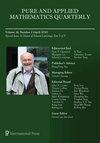关于牛顿二体运动中无限初始分离的潮汐能
IF 0.8
4区 数学
Q3 MATHEMATICS
引用次数: 0
摘要
在 $\href{https://doi.org/10.48550/arXiv.1708.04307}{[8]}$ 中,我们研究了牛顿双体运动中的潮汐能动力学,以及潮汐能如何影响两个相同引力流体的质量中心轨道。$\href{https://doi.org/10.48550/arXiv.1708.04307}{[8]}$中表明,对于一类初始构型,两个流体体的边界形变所引起的潮汐能相对于整个系统的正守恒总能量可以变得任意大。这揭示了一种可能性,即最初无边界的质量中心轨道可能在演化过程中变得有边界。$href{https://doi.org/10.48550/arXiv.1708.04307}{[8]}$中的这一结果是基于潮汐能与两个天体距离之间的定量关系。然而,由于潮汐能在初始时消失,但两体距离是有限的,因此只有当两体距离在第一次最近接近的倍数之内时,这种关系才成立。在这项工作中,基于$\href{https://doi.org/10.48550/arXiv.1708.04307}{[8]}$中建立的先验估计,我们构建了与$\href{https://doi.org/10.48550/arXiv.1708.04307}{[8]}$中相同的两体问题的解,但初始分离是无限的。因此,上述定量关系在第一次最接近之前的整个演化过程中都是成立的。本文章由计算机程序翻译,如有差异,请以英文原文为准。
On tidal energy in Newtonian two-body motion with infinite initial separation
In $\href{https://doi.org/10.48550/arXiv.1708.04307}{[8]}$ we have studied the dynamics of tidal energy in Newtonian two-body motion and how it affects the center-of-mass orbit of two identical gravitating fluid bodies. It is shown in $\href{https://doi.org/10.48550/arXiv.1708.04307}{[8]}$ that for a class of initial configuration, the tidal energy caused by the deformation of boundaries of two fluid bodies can be made arbitrarily large relative to the positive conserved total energy of the entire system. This reveals the possibility that the center-of-mass orbit, which is unbounded initially, may become bounded during the evolution. This result in $\href{https://doi.org/10.48550/arXiv.1708.04307}{[8]}$ is based on a quantitative relation between the tidal energy and the distance of two bodies. However, this relation only holds when the two-body distance are within multiples of the first closest approach, due to the fact that initially the tidal energy vanishes but the two-body distance is finite. In this work, based on the a priori estimates established in $\href{https://doi.org/10.48550/arXiv.1708.04307}{[8]}$, we construct a solution to the same two-body problem as in $\href{https://doi.org/10.48550/arXiv.1708.04307}{[8]}$ but with infinite initial separation. Therefore the above mentioned quantitative relation holds during the entire evolution up to the first closest approach.
求助全文
通过发布文献求助,成功后即可免费获取论文全文。
去求助
来源期刊
CiteScore
0.90
自引率
0.00%
发文量
30
审稿时长
>12 weeks
期刊介绍:
Publishes high-quality, original papers on all fields of mathematics. To facilitate fruitful interchanges between mathematicians from different regions and specialties, and to effectively disseminate new breakthroughs in mathematics, the journal welcomes well-written submissions from all significant areas of mathematics. The editors are committed to promoting the highest quality of mathematical scholarship.

 求助内容:
求助内容: 应助结果提醒方式:
应助结果提醒方式:


